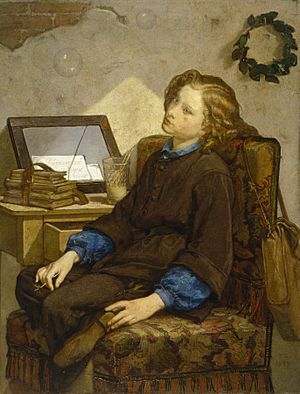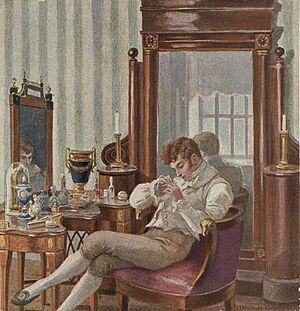Vanity facts for kids
Vanity is when someone believes too much in their own looks or abilities. Before the 14th century, it just meant "uselessness" or "things that don't last." The word vainglory used to mean thinking you're so good you don't need God's help. Even though "glory" sounds positive now, its original Latin meaning was closer to "boasting," which was often seen as a bad thing.
Vanity in Beliefs and Ideas
Many religions see vanity as a form of idolatry. This means someone acts like they are as great as God, focusing only on themselves. This can separate them from God's kindness. In Christian teachings, vanity is a type of pride, which is one of the seven deadly sins. The Baháʼí Faith also talks about "vain imaginings," meaning thoughts that are not real or helpful.
From a thinking point of view, vanity can be a bigger form of egotism or pride. The philosopher Friedrich Nietzsche once said that "vanity is the fear of appearing original." This means it's a lack of true pride, but not necessarily a lack of new ideas. Another thinker, Mason Cooley, wrote that "Vanity well fed is benevolent. Vanity hungry is spiteful." This suggests that if someone's vanity is satisfied, they might be kind, but if it's not, they could become mean.
Symbols of Vanity

In Western art, vanity was often shown using a peacock. In the Bible, the "... of Babylon" also symbolized vanity. In art, a woman looking at herself in a mirror, often fixing her hair, was a common symbol. Sometimes a demon or a small angel-like figure called a putto would hold the mirror. Other symbols of vanity include jewelry, gold coins, a purse, and even the figure of death.
Some artworks about vanity include scrolls that say Omnia Vanitas. This is Latin for "All is Vanity." It comes from the Bible book of Ecclesiastes. While "vanitas" originally meant "emptiness" or the idea that human efforts in this world are pointless, the phrase in art often meant that the person in the picture was completely focused on their own looks.
Art expert Edwin Mullins noted that artists might show a woman admiring herself in a mirror, making it seem like they are criticizing her. But at the same time, the painting lets viewers secretly admire her too. This idea of a woman lying down often mixed with paintings of Venus, the goddess of love, who was not meant to represent vanity.

In his painting of the seven deadly sins, Hieronymus Bosch shows a rich woman looking at herself in a mirror held by a devil. Behind her is an open jewelry box. A painting by Nicolas Tournier called An Allegory of Justice and Vanity shows a young woman holding a balance, which stands for justice. She doesn't look at a mirror or a skull on the table, suggesting she is not vain. Some people think Johannes Vermeer's painting Girl with a Pearl Earring might show vanity because the girl has dressed up without any other positive symbols.
The famous painting All is Vanity by Charles Allan Gilbert (1873–1929) also explores this idea. It's an optical illusion. At first, it looks like a big grinning skull. But if you look closer, you see it's a young woman looking at her reflection in a mirror. In the movie The Devil's Advocate, the character of Satan even says that "vanity is his favourite sin."
These artworks were meant to remind people that youthful beauty doesn't last forever. They also showed how short human life is and that everyone will eventually die.
See also
 In Spanish: Vanidad para niños
In Spanish: Vanidad para niños
- Confidence
- Dunning–Kruger effect
- Grandiose delusions
- Haughtiness
- Icarus complex
- Overconfidence effect
- Self-serving bias
- Bonfire of the Vanities
- Egotism
- False pleasure
- Narcissistic elation
- Selfishness
- Vanitas
- Vanity gallery


